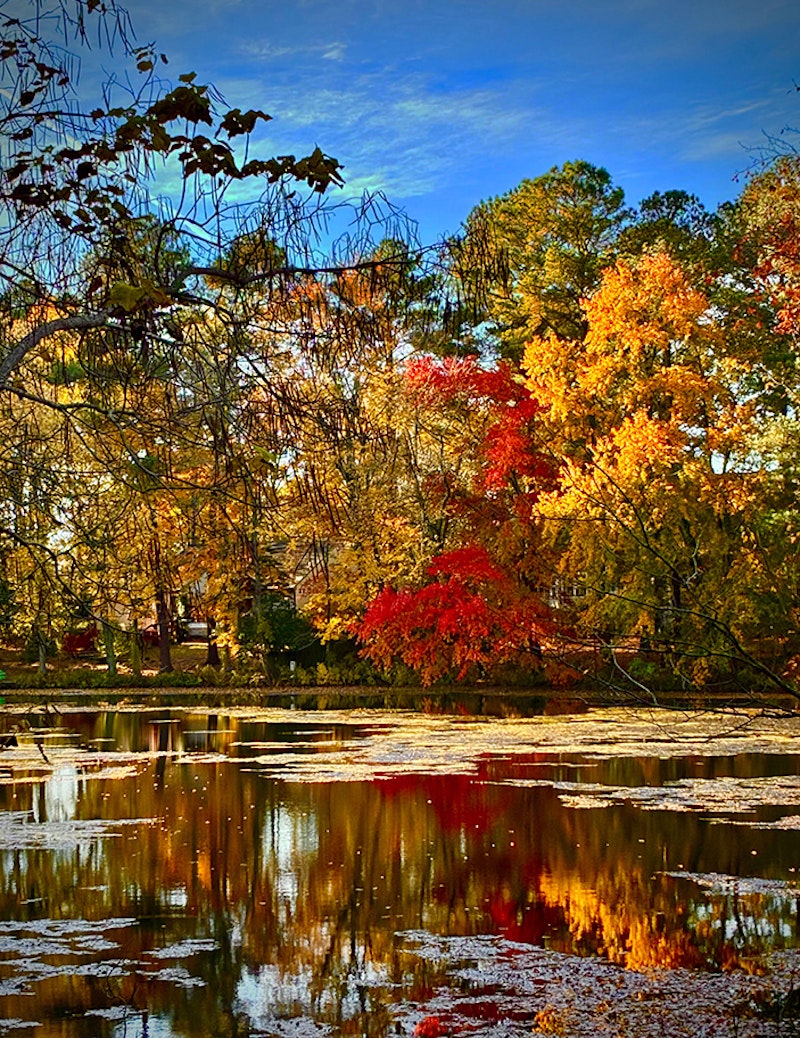Autumn’s orange, red, and yellow displaying contrast against a deep blue sky. A silhouetted horse hits its stride crossing a small slope. A sunny afternoon caresses a white cloud. Steady breezes carry leaves. Walking along a rural roadside, frequently lacks sidewalks. Crab apples and falling acorns are bitter, unpalatable for culinary purposes. Be on the lookout for speeding passing vehicles.
This hidden world, surrounded between the Atlantic Ocean and the Chesapeake and Delaware Bays, is known as the Delmarva Peninsula. The area’s a relatively flat, yet diverse landscape with a centuries-old, diverse history. An economy built around agricultural cultivation is the foundation in these rural communities. Here you’ll find working farms, smalltown four-way crossroads, shopping centers and lots of gas stations. Housing developments spring up on former farmlands. Rivers, marshes, ponds, and substantial woodlands are scattered throughout.
Under a cluster of loblolly pine trees on a mossy conifer mound, dozens of vivid red mushrooms suddenly appear the next morning after a hard night’s rain. These are fly agaric or fly amanita, beautiful and extremely poisonous. The toxic mushroom grows all over the world. From Alice in Wonderland to Fantasia throughout history, its effects are well-documented. This isn’t your go-to psilocybin “Magic Mushroom” seeking good times. Although it looks fairly innocuous, its deadly neurotoxins host a variety of dangers—a deliriant with unpredictable side effects, aptly named the Death Cap, Destroying angel, or Fools’ mushroom. Even thinking about it is a bummer. Keep walking.
On a lighter note, Bucky the squirrel takes a break from his antics under a maple tree shedding leaves. The critter strikes a pose, standing on its hind legs. Surveying strategies, his head twists and turns around. Twiddling an acorn in his hands, he looks for a safe place to hide his treasure. This habit’s called caching. Don’t worry, he’ll remember. Poking his muddy nose in the ground, the excavation work begins.
The area’s biogeochemistry consists of wetlands and marshes with dense undergrowth. The quiet golden ponds are broken the sound by honking geese spreading their wings. Mallard ducks bob their heads feeding on minnows. In nearby fields, crickets fiddle a fading symphony. Filling the air, a rich, musky aroma of earthen decay is everywhere; it’s the smell of dying plant foliage. During the summertime, Southern Delmarva’s heat is brutal. There are biting flies with all-day mosquitoes and ticks. The isolated salt marshes and wetlands aren’t for the weak of heart seeking a pleasant fishing location.
East of Crisfield in the Chesapeake Bay, James Island has disappeared, eroded away by the tides. Efforts to revitalize this vanished ecosystem are underway. Using sediment and silt dredged from the Baltimore Harbor and parts of the northern Bay, the US Army Corps of Engineers are studying plans to rebuild the island. It’s a massive undertaking. The recycled soil will be tested for toxins, placed on freight vessels, then shipped south on the Bay. Plans call for a stone perimeter, though not natural, surrounding the vanished island, hopefully that’ll make it a friendly environment for waterfowl and wildlife.
Suddenly a rare moment. It’s the elusive Japanese Sika deer a 2’5” tall miniature elk. The deer performs a robust hop, skip and a jump across a vast cornfield. The animal having lunch was apparently disturbed by a harvesting tractor. A closer look reveals: a short, stocker hooved species. This breed has a dark, shaggy mane running down its neck, different from the native white-tailed deer.
How did a deer from Japan get to Maryland? Around 1916, Clement Henry imported and released five or six deer from Asia, introducing the species on James Island (when it still existed) for private game preserve use. The imported Sikas most likely swam ashore from the island. Their population flourished. Maryland officials closely monitor their numbers. Sikas are called “marsh ghosts,” they’re shy and steer clear of human contact. They employ “bounce locomotion” heading directly into the cattails at first sight. The animals continue to coexist with minimal damage, having no natural predators except man. Many other invasive creatures live on the peninsula. These animal and plant species include blue catfish, mute swans, Kudzu vine, privet hedge and nutria to name a few.
During the fall, Delmarva residents say this looks a scene straight-out of Alfred Hitchcock’s The Birds. Large flocks of starlings gather on telephone and power lines chattering away. They’re a noisy bunch. The heavens suddenly darken. A murmuration is an awesome spectacle using animal telepathy to think collectively, thousands of birds fly in unison patterns. The natural phenomenon’s stunning. Soaring high above, a Cooper’s hawk keeps a watchful eye on everything below, just in case a stray bird is spotted. Joining the predator, three circling turkey vultures hunt for scraps. Back inside a farmhouse, a current Red Bull tv ad makes an obvious point: “Nature sure is full of wonders.”

